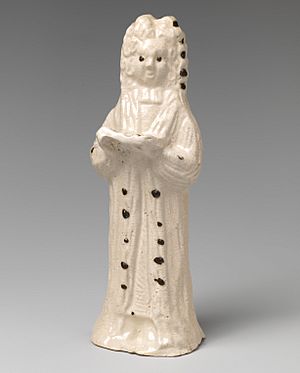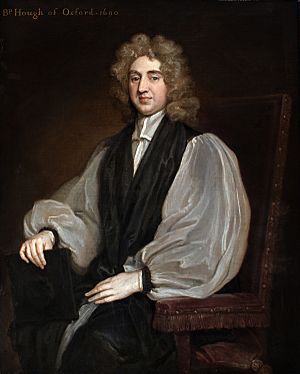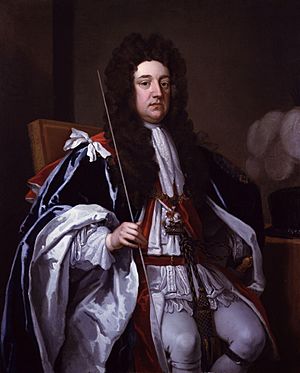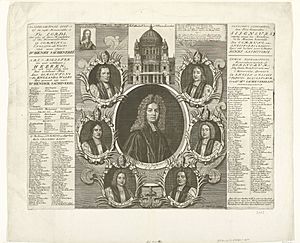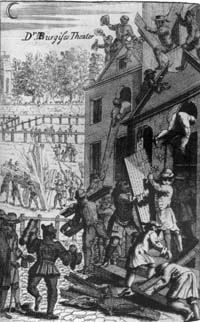Henry Sacheverell facts for kids
Quick facts for kids
Henry Sacheverell
|
|
|---|---|
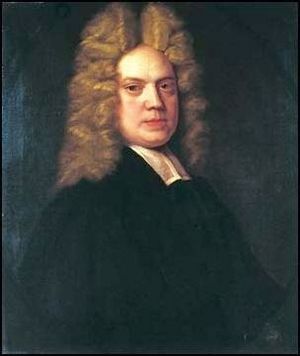
Portrait by Thomas Gibson, 1710
|
|
| Born | 8 February 1674 Marlborough, Wiltshire, England |
| Died | 5 June 1724 (aged 50) Highgate, London |
| Occupation | Church of England clergyman |
| Language | English |
| Alma mater | Magdalen College, Oxford |
| Burial place | St Andrew Holborn |
Henry Sacheverell (born February 8, 1674 – died June 5, 1724) was an English Anglican clergyman. He became very famous in 1709 after giving a powerful sermon. This sermon led to him being put on trial by the House of Commons, a process called impeachment. Even though he was found guilty, his punishment was light. Many people saw this as a victory for him. He became a popular figure across the country. His popularity helped the Tory party win a big election in 1710.
Contents
Early Life and Education
Henry Sacheverell was born in Marlborough, England. His father, Joshua Sacheverell, was a church leader. After his father died in 1684, Henry was adopted by his godfather, Edward Hearst. The Hearsts were very religious and supported the Church of England.
Henry went to Marlborough Grammar School from 1684 to 1689. Then, he went to Magdalen College, Oxford, in 1689. He studied there until 1701 and later became a fellow (a senior member) from 1701 to 1713. He earned his Bachelor of Arts degree in 1693 and his Master of Arts degree in 1695.
In 1695, he became a deacon, which is a step in becoming a priest. He was ordained by the Bishop of Oxford, John Hough. Later, he had a disagreement with another bishop, William Lloyd, about his Latin grammar. Sacheverell, who had written Latin poems, proved he was right!
In 1696, he became a chaplain and curate. However, he was not given a permanent church job at first. Some people thought he was too playful for a clergyman. In 1697, he finally became a vicar in Cannock, Staffordshire.
Early Preaching and Fame
Sacheverell first became well-known in 1702. He gave a sermon called The Political Union. In this sermon, he talked about how important it was for the church and government to be united. He also criticized Dissenters, who were Protestants who did not follow the Church of England. He called for Anglicans to stand strong against those who seemed to be enemies of their church.
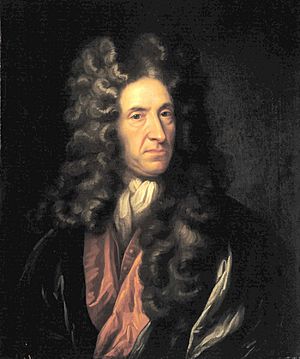
His strong words caught the attention of famous writers. Daniel Defoe even called Sacheverell "the bloody flag officer." Sacheverell continued to preach and publish sermons. He often warned about "false brethren" within the Church. These were people he felt were not truly loyal to the Church of England.
In 1708, he earned a Doctorate of Divinity degree. In 1709, he became a chaplain at St Saviour's in London. This appointment caused some worry among those who disagreed with his views.
The Famous Sermon: The Perils of False Brethren
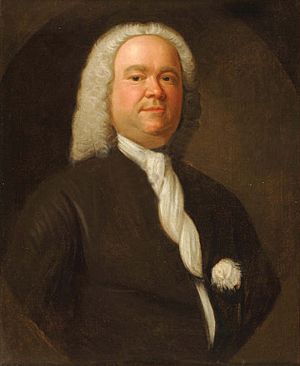
In November 1709, the new Lord Mayor of London, Sir Samuel Garrard, 4th Baronet, asked Sacheverell to preach a special sermon. This sermon was given at St Paul's Cathedral on November 5th. This date was important because it marked two events: the Gunpowder Plot (a plan to blow up Parliament in 1605) and the arrival of William of Orange in 1688, which led to the Glorious Revolution.
Sacheverell's sermon was titled The Perils of False Brethren, in Church, and State. In it, he strongly criticized those he called "false brethren." He said these were people who threatened the Church and the government. He compared the Gunpowder Plot to the execution of King Charles I in 1649, linking both to dangerous ideas.
He attacked Dissenters and those who supported them. He said they were trying to weaken the Church. He also criticized the idea that people could resist the king's power. This was a very sensitive topic, especially after the Glorious Revolution, which had involved resisting a king. Sacheverell even hinted at Sidney Godolphin, a powerful government leader, calling him "Volpone."
Sacheverell ended his sermon by telling loyal Anglicans to unite and fight against these "false brethren." He believed the Church was in danger and needed strong defenders.
Public Reaction and Trial
After the sermon, Sacheverell was cheered by crowds as he left St Paul's. His sermon was quickly printed, and an amazing 100,000 copies were sold. This was a huge number for that time. Many people supported him, seeing him as a hero for the Church.
The Whig government, however, was very worried. Sacheverell had challenged Parliament and criticized a top government official. They decided to put him on trial for seditious libel, which meant speaking out against the government. They wanted to make an example of him.
On December 13, 1709, the House of Commons ordered Sacheverell to appear before them. He was then impeached, meaning he was formally accused of serious wrongdoing. Many important Tory leaders supported him during this time.
Sacheverell's trial lasted from February 27 to March 21, 1710. The verdict was that he was guilty. His punishment was that he could not preach for three years, and his two sermons were ordered to be burned.
After the Trial
Even though he was found guilty, many people saw Sacheverell's light punishment as a victory. He became even more popular, seen as a "saviour of the Church." People celebrated with bonfires and ringing church bells. There were also Sacheverell riots in London and other parts of the country. Mobs attacked and burned down churches belonging to Dissenters. These riots eventually led to the Riot Act being passed in 1714.
Despite his ban from preaching, Sacheverell was given a new church job in Shropshire in 1710. He traveled there in what was called "the most extraordinary Progress." As he traveled, huge crowds greeted him in towns and cities. Thousands of people, including local leaders, welcomed him with cheers and celebrations. Church bells rang from morning until night.
This public support for Sacheverell had a big impact on politics. The general election of 1710 saw a huge victory for the Tory party. Sacheverell's name was shouted by election crowds, and his portrait became a symbol for Tories.
Later Life and Legacy

Sacheverell's ban on preaching ended on March 23, 1713. He preached again at St Saviour's to an enormous crowd. Soon after, he was appointed to a valuable church position at St Andrew's in London.
When Queen Anne died and George I became king, Sacheverell continued to be a strong voice for the Church of England. He criticized those he saw as enemies of the Church. His name was still used by rioters protesting against the new king in 1715.
Sacheverell inherited some land and married in 1716. He bought a house in Highgate, London. He died there on June 5, 1724, after an accident. He was buried at St Andrew's Church.
Historian Greg Jenner has suggested that Henry Sacheverell might have been one of the first "celebrities" in history. His story shows how a preacher could become incredibly famous and influence politics in 18th-century Britain.
|


